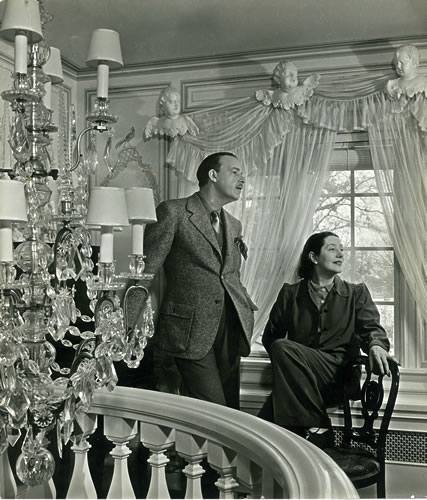Fabulous
I just read Design For Living, Margot Peter's biography of Lunt and Fontanne. They're the last of a generation where the stage was everything. They're all but forgotten today, and that's one reason why that era is gone.
In fact, the book includes scores of names--Pauline Lord, Laurette Taylor, Dudley Digges, etc.--who shone brightly but who wouldn't be recognized by 1 in 100 today. The big stage names that are remembered--Edward G. Robinson, Leslie Howard, Sydney Greenstreet, Helen Hayes--are mostly due to their movie roles.
By the time the Lunts married in 1922 they both were stars, generally associated with comedy. Alfred had the title role in Booth Tarkinton's Clarence in 1919, and Lynn Fontanne had the title role in Kaufman and Connelly's Dulcy in 1921. Lynn was five years older than Alfred, though she claimed to be a year younger. She was not a great beauty, but could play beautiful, which is what counts on the stage.
Peters claims it was a sexless marriage. That they were both bisexuals who favored their own kind. She doesn't dwell on this point, though the claim has apparently angered some readers. Whether it's true or not, the deeper truth is they were married, above all, to the theatre.
Their first big hit together was The Guardsman in 1924. For the first few years of their marriage they sometimes did solo projects (Fontanne was in the original Strange Interlude) but from the late 20s to the late 50s, they only appeared on stage together.
Almost every show they did was a hit, and in addition to being big on Broadway and London, they toured incessantly. The Lunts represented a type of acting and glamor we don't really see any more. It's hard to say how good they were since we can only go on what people of the time said. (Some of it sounds corny--Alfred was famous for acting with his back to the audience at some moment in almost every play.) But apparently they were something special, especially Alfred, who was often called the greatest America actor of his era. If he'd taken on more significant roles, perhaps he could have been another Olivier. They built their performances out of thousands of small details, and worked and worked until the effects paid off. But it's not as if everything they did was external--Lee Strasberg himself said the Lunts were The Method.
Yet many critics, especially in later years, bemoaned that they played it safe. They had the fame and power to pick and choose their projects, but rarely played the classics, and rarely chose works from challenging new playwrights. Instead, most of their work, good or bad, was tailored for them. Few of their titles are revived today. I suppose, in the end, they chose what worked on stage, not what may have lived on after them.
PS The particular copy of the book I borrowed from my library has interesting "notes" added. Some previous reader has written in pencil helpful explanations such as "dyke," "queen," "gay" and so on.



1 Comments:
Nicely done.
Post a Comment
<< Home